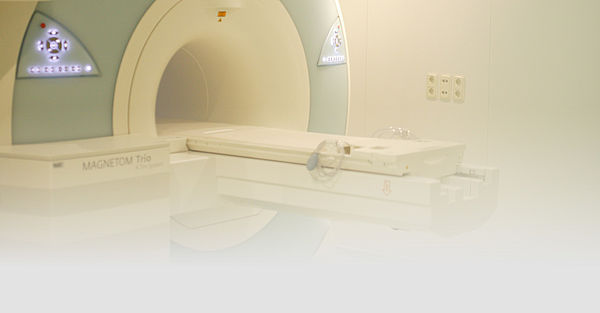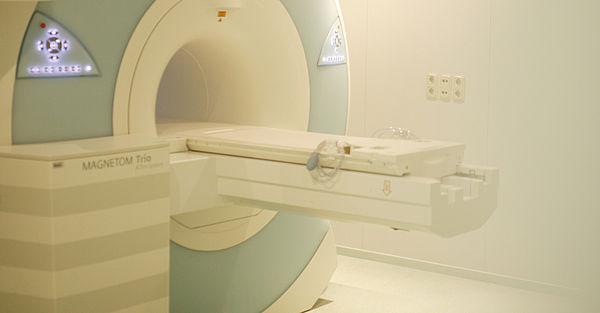

The Research Group "Neuropsychology of Action" is dedicated to investigations of human action control. We study clinical impairments of action control and their neural substrates in patients with brain damage due to stroke or neurodegenerative diseases. Through the observation of typical characteristics of their diseases and their participation in our experimental behavioural studies, these patients help us to understand not only the particular consequences of disorders of the sensory and motor systems but also to draw conclusions on the normal functioning of the intact systems in healthy humans. Our work with the patients motivates functional neuroimaging studies that explore the neuronal foundations of human motor behaviour. We are particulularly interested in the cortical systems of reach-to-grasp movements, cortical systems of tool use and tool evaluation, and sensorimotor functions and networks of the human tectum.
Evaluation of object functionality and mechanical reasoning in humans
Human action control is characterized by its impressive complexity and flexible adjustment in tool use and object manipulation. We aim to investigate the cognitive control mechanisms involved in the evaluation of action affordances associated with an object and their neuronal correlates. How do we recognize an usable tool for a particular technical problem? How do memory and acquired knowledge about tools on the one hand and visual analysis and deductive reasoning on the other hand contribute to our respective decision? A small group of brain-damaged patients are especially impaired in using novel, unfamiliar tools while they are less impaired in using familiar tools. The examination of such patients and further behavioral and neuroimaging studies based on observations in these patients can help us to understand the way different cognitive sources are combined to come up with a motor behavior that no other living species can match.
The human superior colliculi – a small big player in the human brain?
The superior colliculi are located at the upper brainstem of humans. In contradiction of established textbook knowledge, research in nonhuman primates through the last decade demonstrated that the superior colliculi play some role in the execution of arm movements. In our ongoing studies we found clear evidence for its role in the control of arm movements also in healthy humans. However, the precise functional contribution of the colliculi to the processes of planning and execution and the processing of a movement’s sensory feedback is still unknown. To explore this unknown territory we currently develop experimental designs that allow for event-related analyses and transfer our paradigms to the ultra-high field 9,4T scanner at the MPI for High-field Magnetic Resonance. Using tensor imaging and resting state fMRI we investigate the connectivity of the superior colliculi within the sensorimotor network. First studies in nonhuman primates have already demonstrated a connection between the functions of superior colliculi and the appearance of motor disorders like cervical dystonia. A precise functional mapping of the colliculi in living humans will not only be important for the understanding of neurological motor disorders but might also reveal that this concise structure could be good candidate regions in the framework of neuroprosthetics and brain stimulation in the future.
The impact of object knowledge on visual motor control
We grasp a screwdriver in a specific way if we are about to use it and in a very different way if we just want to put it aside. Despite of such quite obvious dependencies of visual motor control on object recognition, many researchers believe that the actual control of human grasping depends almost entirely on the direct visual information about object sizes irrespective of any stored knowledge in our memory. In contrast, we demonstrated that well established associations, build through a long-term learning process, are powerful enough to change visual motor control. Interestingly, we also observed some patients with impairments in the control of grasping who apparently exploited such associations for an individual improvement: they are better in grasping very familiar in comparison to neutral geometrical objects. Our work suggests that the role of object familiarity on the control of movements was underestimated in the past.
The role of dorsal and ventral visual systems on motor control
The two-visual-stream model of visual perception and visual action control had a considerable influence on the cognitive neuroscience of perception and action control over that last 25 years. As influential as it is, it also became heavily critisized by many researchers. Appreciating the enormous impetus of this model we scrutinise some of its basic assumptions and postulations. Thus, we investigate the influence of delays on hand- and arm-movement accuracy in healthy humans and patients with brain damage, particularly patients with optic ataxia or visual agnosia. We look into the cortical systems of online movement corrections and map the functional responses of the human parieto-occipital cortex during visually-guided reaching.
Journal Articles
Loureiro JR, Hagberg GE, Ethofer T, Erb M, Bause J, Ehses P, Scheffler K, Himmelbach M (2017) Depth-dependence of visual signals in the human superior colliculus at 9.4 T. Human Brain Mapping 38:574-587.
Vogel AP, Rommel N, Sauer C, Horger M, Krumm P, Himmelbach M, Synofzik M (2017) Clinical assessment of dysphagia in neurodegeneration (CADN): development, validity and reliability of a bedside tool for dysphagia assessment. Journal of Neurology 264:1107-1117.
Belardinelli A, Barabas M, Himmelbach M, Butz M (2016) Anticipatory eye fixations reveal tool knowledge for tool interaction. Experimental Brain Research 234: 2415-2431.
Cornelsen S, Rennig J, Himmelbach M (2016) Memory-guided reaching in a patient with visual hemiagnosia. Cortex 79: 32-41.
Bloechle J, Huber S, Bahnmueller J, Rennig J, Willmes K, Seda C, Moeller K, Klein E (2016) Fact learning in complex arithmetic – the role of the angular gyrus revisited. Human Brain Mapping 37: 3061-3079.
Liew SL, Rana M, Cornelsen S, Fortunato de Barros Filho M, Birbaumer N, Sitaram R, Cohen LG, Soekadar SR (2016) Improving motor corticothalamic communication after stroke using real-time fMRI connectivity-based neurofeedback. Neurorehabilitation and Neural Repair 30: 671-675.
Rennig J, Himmelbach M, Huberle E, Karnath H-O (2015) Involvement of the TPJ area in processing of novel global forms. Journal of Cognitive Neuroscience 27:1587-1600
Martin JA, Karnath HO, Himmelbach M (2015). Revisiting the cortical system for peripheral reaching at the parieto-occipital junction. Cortex 64: 363-379.
Borchers S, Verheij R, Smeets JBJ, Himmelbach M (2014). The influence of object height on maximum grip aperture in empirical and modelled data. Journal of Experimental Psychology: Human Perception and Performance 40: 889-96.
Suchan J, Umarova R, Schnell S, Himmelbach M, Weiller C, Karnath H-O, Saur D (2014). Fiber pathways connecting cortical areas relevant for spatial orienting and exploration. Human Brain Mapping 35: 1031-43.
Schell C, Suchan J, Himmelbach M, Haarmeier T, Borchers S (2014). Limb apraxia in acute ischemic stroke – a neglected clinical challenge? Neurocase 20: 158-162.
Rennig J, Bilalic M, Huberle E, Karnath HO, Himmelbach M (2013). The temporo-parietal junction contributes to global gestalt perception – evidence from studies in chess experts. Frontiers in Human Neuroscience 7: 513.
Borchers S, Synofzik M, Kiely E, Himmelbach M (2013). Routine clinical testing underestimates proprioceptive deficits in Friedreich‘s ataxia. Cerebellum 12: 916-922.
Borchers S, Müller L, Synofzik M, Himmelbach M (2013). Guidelines and quality measures for the diagnosis of optic ataxia. Frontiers in Human Neuroscience 7: 324.
Himmelbach M, Linzenbold W, Ilg UJ (2013). Dissociation of reach-related and visual signals in the human superior colliculus. Neuroimage 82: 61-67.
Christensen A, Borchers S, Himmelbach M (2013). Effects of pictorial cues on reaching depend on the dictinctiveness of target objects. PLoS one 8: e54230.
Linzenbold W, Himmelbach M (2012). Signals from the deep: reach-related activity in the human superior colliculus. Journal of Neuroscience 32: 13881-13888.
Borchers S, Himmelbach M (2012). The recognition of everyday objects changes grasp scaling. Vision Research 67: 8-13. Manuscript PDF
Balslev D, Himmelbach M, Karnath H-O, Borchers S, Odoj B (2012). Eye proprioception used for visual localization only if in conflict with the oculomotor plan. Journal of Neuroscience 32: 8569-73.
Himmelbach M, Boehme R, Karnath H-O (2012). 20 years later: A second look on DF's motor behaviour. Neuropsychologia 50: 139-144. Manuscript PDF
Borchers S, Himmelbach M, Logothetis N, Karnath H-O (2012). Direct electrical stimulation of human cortex – the gold standard for mapping brain functions? Nature Reviews Neuroscience 13: 63-70.Manuscript PDF
Borchers S, Hauser TK, Himmelbach M (2011). Bilateral hand representations in human primary proprioceptive areas. Neuropsychologia 49: 3383-3391.Manuscript PDF
Linzenbold W, Lindig T, Himmelbach M (2011). Functional neuroimaging of the oculomotor brainstem network in humans. Neuroimage 57: 1116-1123.Manuscript PDF
Borchers S, Christensen A, Ziegler L, Himmelbach M (2011). Visual action control doesn’t rely on strangers - effects of pictorial cues under monocular and binocular vision. Neuropsychologia 49: 556-563.
Karnath H-O, Borchers S, Himmelbach M (2010). Comment on „Movement Intention After Parietal Cortex Stimulation in Humans“. Science 327: 1200-c.
Karnath H-O, Rüter J, Mandler A, Himmelbach M (2009). The Anatomy of Object Recognition—Visual Form Agnosia Caused by Medial Occipitotemporal Stroke. Journal of Neuroscience 29: 5854-5862.
Himmelbach M, Nau M, Zündorf I, Erb M, Perenin M-T, Karnath, H-O (2009). Brain activation during immediate and delayed reaching in optic ataxia. Neuropsychologia 47: 1508-1517.
Himmelbach M, Erb M, Klockgether T, Moskau S, Karnath H-O (2009). fMRI of global visual perception in simultanagnosia. Neuropsychologia 47: 1173-1177.
Seymour K, Karnath H-O, Himmelbach M. (2008). Perceptual grouping in the human brain: common processing of different cues. NeuroReport 19: 1769-1772.
Himmelbach M, Erb M, Karnath H-O. (2007). Activation of superior colliculi in humans during visual exploration. BMC Neuroscience 8: 66.
Himmelbach M, Karnath H-O, Perenin M-T. (2007). Action control is not affected by spatial neglect: a comment on Coulthard et al. Neuropsychologia 45: 1979-1981.
Himmelbach M, Karnath H-O, Perenin M-T, Franz VH, Stockmeier K. (2006). A general deficit of the 'automatic pilot' with posterior parietal cortex lesions? Neuropsychologia 44: 2749-2756.
Himmelbach M, Erb M, Karnath H-O (2006). Exploring the visual world: the neural substrate of spatial orienting. Neuroimage 32: 1747-1759.
Himmelbach M, Karnath H-O (2005). Dorsal and ventral stream interaction: contributions from optic ataxia. Journal of Cognitive Neuroscience 17: 632-640.
Himmelbach M, Karnath H-O (2003). Goal-directed hand movements are not affected by the biased space representation in spatial neglect. Journal of Cognitive Neuroscience 15: 972-980.
Karnath H-O, Himmelbach M, Perenin M-T (2003). Neglect-like behaviour in healthy subjects: dissociation of space exploration and goal-directed pointing following vestibular stimulation. Experimental Brain Research 153: 231-238.
Karnath H-O, Himmelbach M, Küker W (2003). The cortical substrate of visual extinction. NeuroReport 14: 437-442, Erratum 14: 1189.
Karnath H-O, Himmelbach M (2002). Strategies of lesion localization - Reply to Marshall, Fink, Halligan and Vallar. Cortex 38: 258-260.
Karnath H-O, Himmelbach M, Rorden C (2002). The subcortical anatomy of human spatial neglect: putamen, caudate nucleus, and pulvinar. Brain 125: 350-360.
Karnath H-O, Ferber S, Himmelbach M (2001). Spatial awareness is a function of the temporal not the posterior parietal lobe. Nature 411: 950-953.
Jäncke L, Himmelbach M, Shah NJ, Zilles K (2000). The effect of switching between sequential and repetitive movements on cortical activation. Neuroimage 12: 528-537.
Jäncke L, Peters M, Himmelbach M, Nösselt T, Shah J, Steinmetz H (2000). fMRI study of bimanual coordination. Neuropsychologia 38: 164-74.
Konczak J, Himmelbach M, Perenin M-T, Karnath H-O (1999). Do patients with neglect show abnormal hand velocity profiles during tactile exploration of peripersonal space? Experimental Brain Research 128: 219-223.
Taylor JG, Jäncke L, Shah NJ, Nösselt T, Schmitz N, Himmelbach M, Kalenscher T, Müller-Gärtner HW (1998). A three stage model of awareness: formulation and initial experimental support. Neuroreport 9: 1787-92.
Jäncke L, Specht K, Mirzazade S, Loose R, Himmelbach M, Lutz K, Shah NJ (1998). A parametric analysis of the 'rate effect' in the sensorimotor cortex: a functional magnetic resonance imaging analysis in human subjects. Neuroscience Letters 252: 37-40.
Buchkapitel
Himmelbach M (2013). Der Mensch denkt - Möglichkeiten und Grenzen der bildgebenden Hirnforschung. In: J Audretsch, K Nagorni (eds.) Der Mensch und sein Gehirn. Karlsruhe, Evangelische Akademie Baden, 12-68.
Perenin MT, Himmelbach M (2012). Optische Ataxie. In: H-O Karnath, P Thier (eds.) Kognitive Neurowissenschaften. 3. Auflage. Heidelberg, Springer, 389-402.
Himmelbach M (2011). Störungsspezifische Diagnostik: Optische Ataxie. In: D Nowak (ed.) Handfunktionsstörungen in der Neurologie. Heidelberg, Springer, 151-154.
Himmelbach M (2011). Störungsspezifische Therapie: Optische Ataxie. In: D Nowak (ed.) Handfunktionsstörungen in der Neurologie. Heidelberg, Springer, 353-355.
Himmelbach M, Karnath H-O (2007). Optic ataxia: a gateway to the human visual action system. In: F Mast, L Jäncke (eds.) Spatial processing in navigation, imagery and perception. New York, Springer, 85-105.
Himmelbach M, Karnath H-O (2006). Optische Ataxie. In: Karnath H-O, Hartje W, Ziegler W (eds.) Kognitive Neurologie. Stuttgart, Thieme, 144-147.

Hertie Center of Neurology
Hertie Institute for Clinical Brain Research
Otfried-Müller-Str. 27
72076 Tübingen
Phone: +49 (0)7071 29-81943
Fax: +49 (0)7071 29-5957








